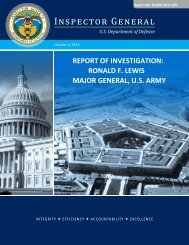Command Red Team
2gWzzvB
2gWzzvB
Create successful ePaper yourself
Turn your PDF publications into a flip-book with our unique Google optimized e-Paper software.
<strong>Red</strong> <strong>Team</strong> Challenges<br />
case, closed-minded individuals who refuse to consider any alternatives, and<br />
uncompromising individuals who strictly adhere to preconceived notions or community<br />
positions. Such individuals can serve a positive role by ensuring that more views are<br />
presented, but they may also frustrate efforts to fully examine other alternatives, and they<br />
may cause the group to adopt the position of its most vocal or immoveable member in<br />
order to move on to other tasks. In such cases, the red team may have to use its own<br />
powers of persuasion to broaden the scope of deliberations, taking care to avoid<br />
approaches that could generate resistance. In addition, the red team itself needs to ensure<br />
it does not adopt an approach that might unduly sway the group or constrain<br />
deliberations.<br />
(7) Death by Coordination. With or without red team support, a working<br />
group may consider all aspects of a problem, explore the full range of potential solutions,<br />
and develop a well-crafted draft product. During subsequent coordination, well-meaning<br />
staff officers and section chiefs might make incremental modifications to the draft and<br />
tone down one contentious point after another, successively moderating the draft’s<br />
language, stripping away its key judgments, and watering down its impact. In such<br />
situations, the red team may be able to circulate its own separate product, one that<br />
incorporates all the working group’s key points, but that is reviewed and approved<br />
through the red team’s separate staffing channels. Essentially, the red team can act as the<br />
staff’s backchannel surrogate, bypassing roadblocks in order to present less diluted<br />
assessments, recommendations, unconventional findings, or to propose unorthodox<br />
solutions to key decision makers.<br />
(8) Institutional Inertia. Working groups may decide that existing<br />
assessments are adequate for the purpose at hand, assuming that the OE has not changed<br />
enough to require a new look, or presuming that published community positions already<br />
incorporate all perspectives to the relevant problem. Since a decision to revise standing<br />
plans or products could result in considerable new work by specific members of the<br />
group and would delay progress by the entire group, there is strong pressure to accept<br />
previously published assessments as they are. If the production of the original<br />
assessment was especially difficult or contentious, the pressure against revising it will be<br />
even stronger. Operationally, the group could expend more energy in a futile effort to<br />
execute the plan as written, regardless of circumstances, than would be required to adapt<br />
the plan to meet new requirements or exploit new conditions. The red team mission is to<br />
encourage the group to critically re-examine existing plans and assessments to verify<br />
their validity, and when necessary, point out sections that may no longer apply, and to<br />
offer alternative perspectives that the standing assessments may not address.<br />
(9) Hubris. Overconfidence and complacency can blind a staff to changing<br />
conditions and adversary adaptations. Staffs may assume their analysis is flawless and<br />
any alternative assessments must be inherently invalid or that their plans have anticipated<br />
all contingencies and will be executed exactly as planned, with no unintended<br />
consequences or negative second and third order effects. <strong>Red</strong> teams were specifically<br />
created to help overconfident staffs avoid such potentially fatal errors, especially staffs<br />
that tend to deny their need for red team support. Staffs operating under the illusion that<br />
III-9



